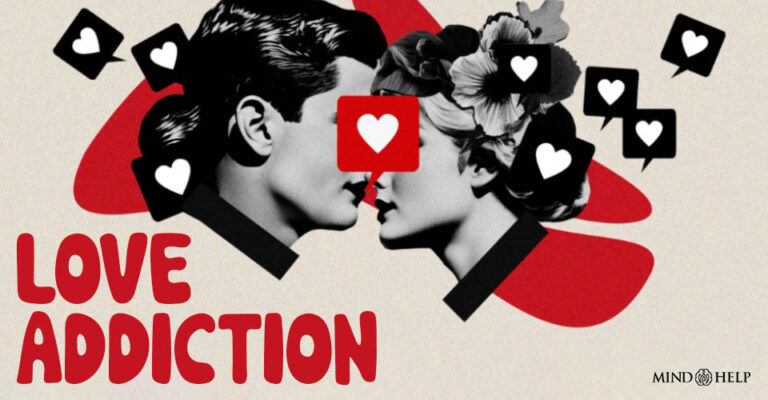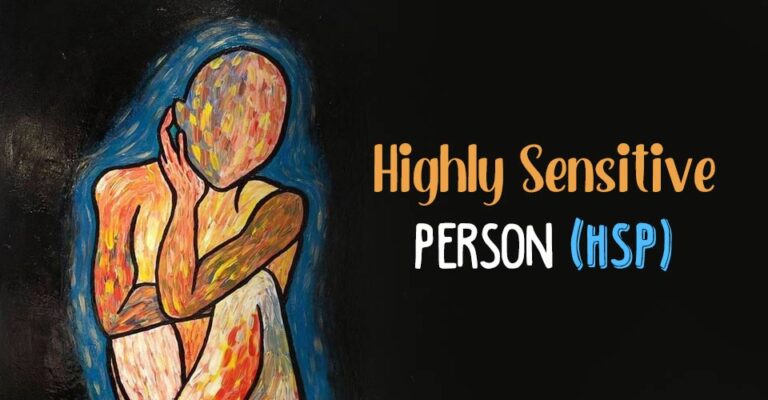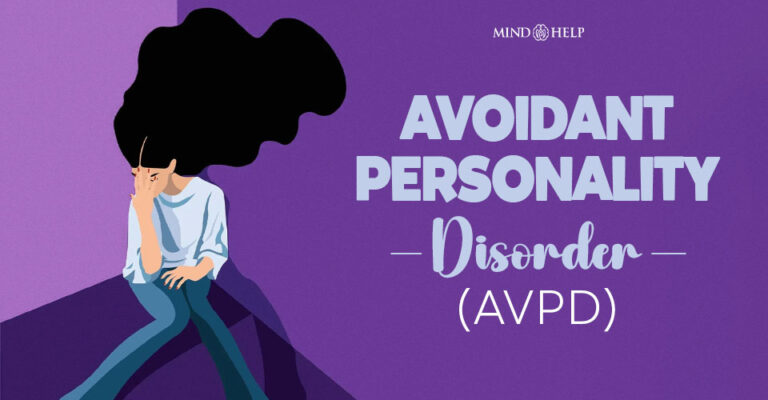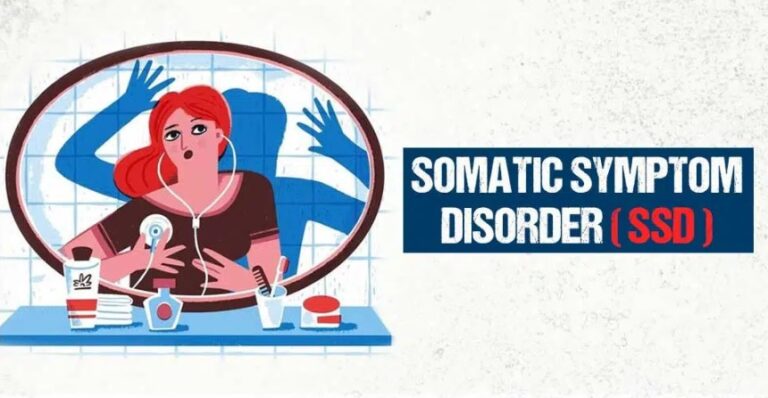Catatonia is a mental health condition characterized by a range of symptoms, including reduced movement, communication difficulties, agitation, confusion, and restlessness. If left untreated, it can seriously hamper a person’s social relationships, career prospects, and daily functioning.
What Is Catatonia?
Catatonia is a complex neuropsychiatric syndrome 1 Burrow, J. P., Spurling, B. C., & Marwaha, R. (2021). Catatonia. PubMed; StatPearls Publishing. Available from: https://www.ncbi.nlm.nih.gov/books/NBK430842/ characterized by a range of motor and behavioral abnormalities. It is typically associated with various mental health disorders and can be considered a major symptom of these conditions.
Catatonia symptoms can occur in the context of psychiatric disorders, such as schizophrenia, bipolar disorder, major depressive disorder, and other mental illnesses. In the Diagnostic and Statistical Manual of Mental Disorders (DSM-5), catatonia is classified as a specifier for several mental health disorders 2 Fink M. (2011). Catatonia from its creation to DSM-V: Considerations for ICD. Indian journal of psychiatry, 53(3), 214–217. https://doi.org/10.4103/0019-5545.86810 .
Prevalence Of Catatonia
The global prevalence of catatonia is not precisely known, as it often goes undiagnosed or is misdiagnosed. However, studies 3 Edinoff, A. N., Kaufman, S. E., Hollier, J. W., Virgen, C. G., Karam, C. A., Malone, G. W., Cornett, E. M., Kaye, A. M., & Kaye, A. D. (2021). Catatonia: Clinical Overview of the Diagnosis, Treatment, and Clinical Challenges. Neurology international, 13(4), 570–586. https://doi.org/10.3390/neurolint13040057 suggest that catatonia is more common in certain populations, such as individuals with schizophrenia or mood disorders. It can affect people of all age groups, but it is more frequently observed in adults.
Symptoms Of Catatonia
The common 4 Bhati, M. T., Datto, C. J., & O’Reardon, J. P. (2007). Clinical manifestations, diagnosis, and empirical treatments for catatonia. Psychiatry (Edgmont Pa. : Township), 4(3), 46–52. catatonia symptoms include:
- Stupor: Profound unresponsiveness and immobility.
- Catalepsy: Extended periods of rigid, fixed body posture.
- Waxy Flexibility: Limbs can be easily positioned by others due to reduced resistance.
- Mutism: Complete absence or severe reduction of speech.
- Negativism: Oppositional behavior, doing the opposite of what is asked.
- Posturing: Assuming unusual and prolonged body positions.
- Mannerisms: Distinctive and repetitive individual behaviors or gestures.
- Stereotypy: Repetitive, non-functional movements or actions.
- Agitation: Restlessness, heightened motor activity, inability to sit still.
- Grimacing: Involuntary or exaggerated facial expressions indicating discomfort.
- Echolalia: Repeating or echoing words or phrases of others.
- Echopraxia: Imitating or mimicking movements and gestures of others.
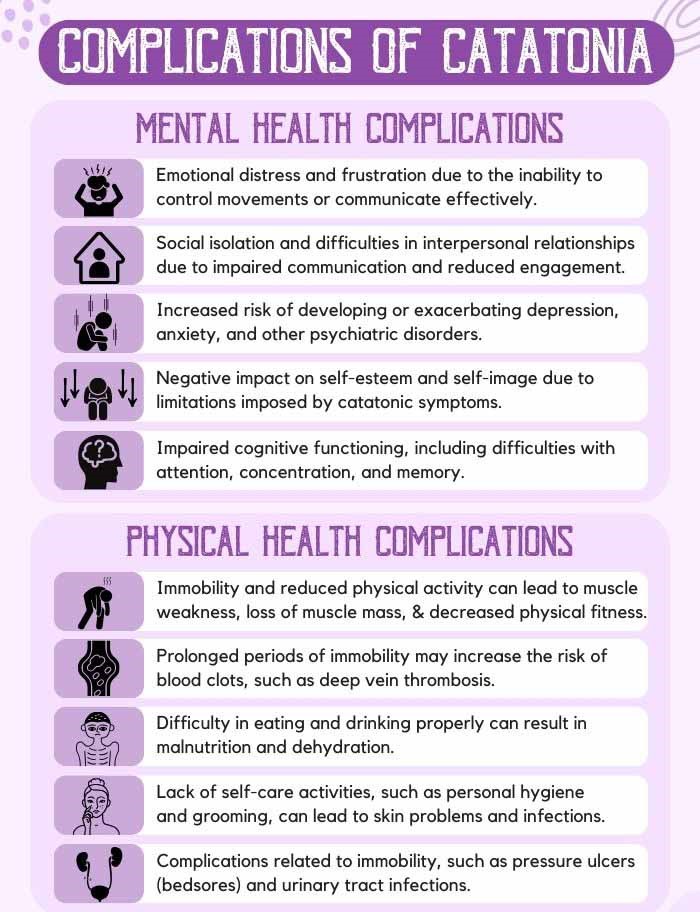
Types Of Catatonia
The catatonia symptoms can be classified into different types 5 Ariza-Salamanca, D. F., Corrales-Hernández, M. G., Pachón-Londoño, M. J., & Hernández-Duarte, I. (2022). Molecular and cellular mechanisms leading to catatonia: an integrative approach from clinical and preclinical evidence. Frontiers in molecular neuroscience, 15, 993671. https://doi.org/10.3389/fnmol.2022.993671 based on its presentation 6 Wilcox, J. A., & Reid Duffy, P. (2015). The Syndrome of Catatonia. Behavioral sciences (Basel, Switzerland), 5(4), 576–588. https://doi.org/10.3390/bs5040576 and underlying causes:
1. Classic Catatonia
This refers to the typical presentation of catatonia, characterized by motor abnormalities such as immobility, posturing, and waxy flexibility.
2. Malignant Catatonia
Malignant catatonia is a severe and potentially life-threatening form of catatonia. It is often associated with underlying medical conditions, such as neuroleptic malignant syndrome or certain infections. Symptoms may include high fever, autonomic dysfunction, delirium, and severe psychomotor disturbances.
3. Neuroleptic-Induced Catatonia
This type of catatonia is caused by the use of certain medications, particularly antipsychotic drugs. It can occur in individuals with or without a history of catatonia. Symptoms may arise shortly after starting or increasing the dosage of neuroleptic medications.
4. Mood Disorder-Related Catatonia
Catatonia can occur in the context of mood disorders, such as major depressive disorder or bipolar disorder. It may manifest as severe psychomotor retardation, immobility, or excessive and purposeless motor activity.
Read More About Major Depressive Disorder Here
5. Organic Catatonia
Organic catatonia refers to catatonic symptoms resulting from an underlying medical condition or substance use. Causes may include metabolic disorders, brain injuries, infections, or intoxication with certain substances.
6. Withdrawal Catatonia
This type of catatonia can be seen during withdrawal from substances such as alcohol or benzodiazepines. It is characterized by a range of catatonic symptoms, including motor immobility and psychomotor disturbances.
Read More About Withdrawal Here
7. Excited Catatonia
Excited or agitated catatonia is a subtype of catatonia characterized by pronounced psychomotor agitation, restlessness, and hyperactivity. Individuals with excited catatonia may exhibit purposeless, repetitive movements, increased impulsivity, and heightened arousal.
8. Mixed Catatonia
Mixed catatonia refers to a complex catatonic syndrome characterized by the presence of symptoms from both the excited and retarded types of catatonia. It involves a combination of motor abnormalities, such as agitation and hyperactivity, as well as features of stupor, immobility, or mutism.
What Causes Catatonia?
The common reasons 7 Walther, S., Stegmayer, K., Wilson, J. E., & Heckers, S. (2019). Structure and neural mechanisms of catatonia. The lancet. Psychiatry, 6(7), 610–619. https://doi.org/10.1016/S2215-0366(18)30474-7 behind what causes catatonia include:
- Psychiatric disorders (like schizophrenia, bipolar disorder, and major depressive disorder)
- Neurological disorders, brain tumors, and autoimmune diseases
- Substance use or withdrawal (related to alcohol, benzodiazepines, etc.)
- Medications, especially neuroleptic medications
- Genetic predisposition and a family history of catatonia
- High levels of stress or traumatic experiences
- Certain infections (like encephalitis and meningitis)
- Electrolyte imbalances (related to low potassium or magnesium)
- Brain injury or damage
- Co-occurring medical conditions (like epilepsy, Parkinson’s disease, etc.)
- Vulnerability in developmental periods such as during adolescence and young adulthood
Mental Health Impact Of Catatonia
Catatonia, as a symptom of an underlying mental health condition 8 Wilcox, J. A., & Reid Duffy, P. (2015). The Syndrome of Catatonia. Behavioral sciences (Basel, Switzerland), 5(4), 576–588. https://doi.org/10.3390/bs5040576 , negatively impacts a person’s mental health in several ways. These include:
- Impaired daily functioning and reduced quality of life
- Feelings of frustration, helplessness, and distress
- Social isolation and difficulties in relationships
- Increased risk of depression and anxiety disorders
- Negative impact on self-esteem and self-image
- Cognitive difficulties, including attention and memory problems
- Disruption of academic or occupational performance
- Impaired decision-making and problem-solving abilities
- Feelings of stigma and misunderstanding
- Increased vulnerability to co-occurring conditions
- Overall psychological distress and reduced well-being
Mental Health Disorders Associated With Catatonia
Catatonia can occur in individuals with mental health conditions 9 Novac, A. A., Bota, D., Witkowski, J., Lipiz, J., & Bota, R. G. (2014). Special medical conditions associated with catatonia in the internal medicine setting: hyponatremia-inducing psychosis and subsequent catatonia. The Permanente journal, 18(3), 78–81. https://doi.org/10.7812/TPP/13-143 wherein the symptoms of catatonia usually range from motor immobility to excessive motor activity, psychomotor retardation, and withdrawal. These mental health disorders include:
- Schizophrenia
- Bipolar disorder (during manic or depressive episodes)
- Major depressive disorder
- Neurodevelopmental disorders like autism spectrum disorder
- Substance-induced catatonia (due to substance use or withdrawal)
- Mood disorders with psychotic features
Read More About Schizophrenia Here
Diagnosis Of Catatonia
The diagnostic criteria outlined in the DSM-5 are used to assess if the patient meets the criteria for catatonia as a specifier for a specific mental health disorder. Diagnosing the symptoms of catatonia 10 Rasmussen, S. A., Mazurek, M. F., & Rosebush, P. I. (2016). Catatonia: Our current understanding of its diagnosis, treatment and pathophysiology. World journal of psychiatry, 6(4), 391–398. https://doi.org/10.5498/wjp.v6.i4.391 also involves a clinical assessment, including a detailed medical history and psychiatric evaluation, along with observation of symptoms and physical examination. Laboratory tests may be conducted to assess underlying medical conditions and neuroimaging can be used to rule out organic causes.
Differential diagnosis with clinical tools [like the Bush-Francis Catatonia Rating Scale 11 Kirkhart, R., Ahuja, N., Lee, J. W., Ramirez, J., Talbert, R., Faiz, K., Ungvari, G. S., Thomas, C., & Carroll, B. T. (2007). The detection and measurement of catatonia. Psychiatry (Edgmont (Pa. : Township)), 4(9), 52–56. (BFCRS)] is important to distinguish catatonia from other similar conditions. Expertise and clinical judgment are essential for an accurate and timely diagnosis as well as the formulation of an effective plan for the treatment for catatonia.
Read More About DSM Here
Treatment For Catatonia
The common approaches 12 Walther, S., Stegmayer, K., Wilson, J. E., & Heckers, S. (2019). Structure and neural mechanisms of catatonia. The lancet. Psychiatry, 6(7), 610–619. https://doi.org/10.1016/S2215-0366(18)30474-7 in treatment for catatonia are tailored to the specific needs and circumstances of the affected. These include:
1. Antipsychotic medications
In some cases, antipsychotic medications—such as risperidone, olanzapine, or Benzodiazepines—may be used cautiously to manage catatonia including alleviating symptoms and promoting relaxation. However, their use should be carefully monitored due to the risk of exacerbating symptoms or causing adverse effects.
2. NMDA Receptor Agonists
Medications that target N-methyl-D-aspartate (NMDA) receptors, such as amantadine or memantine, have shown efficacy in the treatment for catatonia, especially in cases associated with NMDA receptor dysfunction.
3. Physical Therapy And Occupational Therapy
These therapies can be beneficial in improving motor function, mobility, and overall physical well-being in individuals with catatonia.
4. Electroconvulsive Therapy (ECT)
ECT is an effective option in the treatment for catatonia, particularly in cases where other treatments have been ineffective. It involves administering electrical currents to the brain to induce controlled seizures, leading to symptom improvement.
Overcoming Catatonia
Consider the following measures 13 Smith, S. L., Grelotti, D. J., Fils-Aime, R., Uwimana, E., Ndikubwimana, J. S., Therosme, T., Severe, J., Dushimiyimana, D., Uwamariya, C., Bienvenu, R., Alcindor, Y., Eustache, E., Raviola, G. J., & Fricchione, G. L. (2015). Catatonia in resource-limited settings: a case series and treatment protocol. General hospital psychiatry, 37(1), 89–93. https://doi.org/10.1016/j.genhosppsych.2014.10.009 to address symptoms of catatonia:
- Create a calm and structured environment, maintaining a routine and providing reassurance to help manage catatonic symptoms.
- Encourage open communication and provide emotional support to the individual with catatonia, promoting their engagement and participation in treatment.
- Educate yourself about catatonia to better understand its challenges and support your loved one effectively.
- Collaborate with healthcare professionals and actively participate in the individual’s treatment plan, ensuring adherence to medications and therapy sessions.
- Maintain a supportive and nurturing environment, fostering a sense of safety and trust for the individual with catatonia to aid in their recovery.
- Be patient and understanding, as overcoming catatonia can be a gradual process requiring time and perseverance.
- Seek additional resources and support, such as support groups or therapy for family members, to cope with the challenges associated with catatonia.
Takeaway
Catatonia is a complex and often misunderstood condition that profoundly affects individuals. Timely recognition and medical intervention are essential, as appropriate diagnosis and treatment, including medications and support, can lead to significant improvements and restored control.
Raising awareness and understanding of catatonia among healthcare professionals, caregivers, and the community is vital to ensure those affected receive the necessary care. While many individuals respond well to prescribed medications, relapse rates can be high, making ongoing communication with healthcare professionals crucial to assess and adjust treatment for optimal symptom management.
At A Glance
- Catatonia is a complex psychomotor syndrome associated with life-threatening complications in patients with acute psychiatric illnesses.
- Catatonia symptoms include abnormal behavior, reduced movement, and impaired communication.
- Based on the symptoms of catatonia, the disorder can be classified into six types.
- The reasons behind what causes catatonia include comorbid psychiatric disorders, neurodevelopmental disorders, brain abnormalities, and certain medical conditions such as cerebral folate deficiency, rare autoimmune disorders, and rare paraneoplastic disorders.
- Management typically involves long-term treatment for catatonia with medications and electroconvulsive therapy (ECT) as appropriate.
Frequently Asked Questions (FAQs)
1. What Is Catatonic Depression?
Catatonic depression is a subtype of depression characterized by psychomotor disturbances and immobility.
2. What Is Malignant Catatonia?
Malignant catatonia is a severe and potentially life-threatening form of catatonia associated with fever, autonomic dysfunction, and delirium.
3. How Long Does Catatonia Last?
The duration of catatonia symptoms can vary widely depending on the individual and underlying cause, ranging from days to months.
4. Is Catatonia A Negative Symptom Of Schizophrenia?
Catatonia can be considered a negative symptom of schizophrenia, characterized by a decrease or absence of usual behaviors and emotions.

